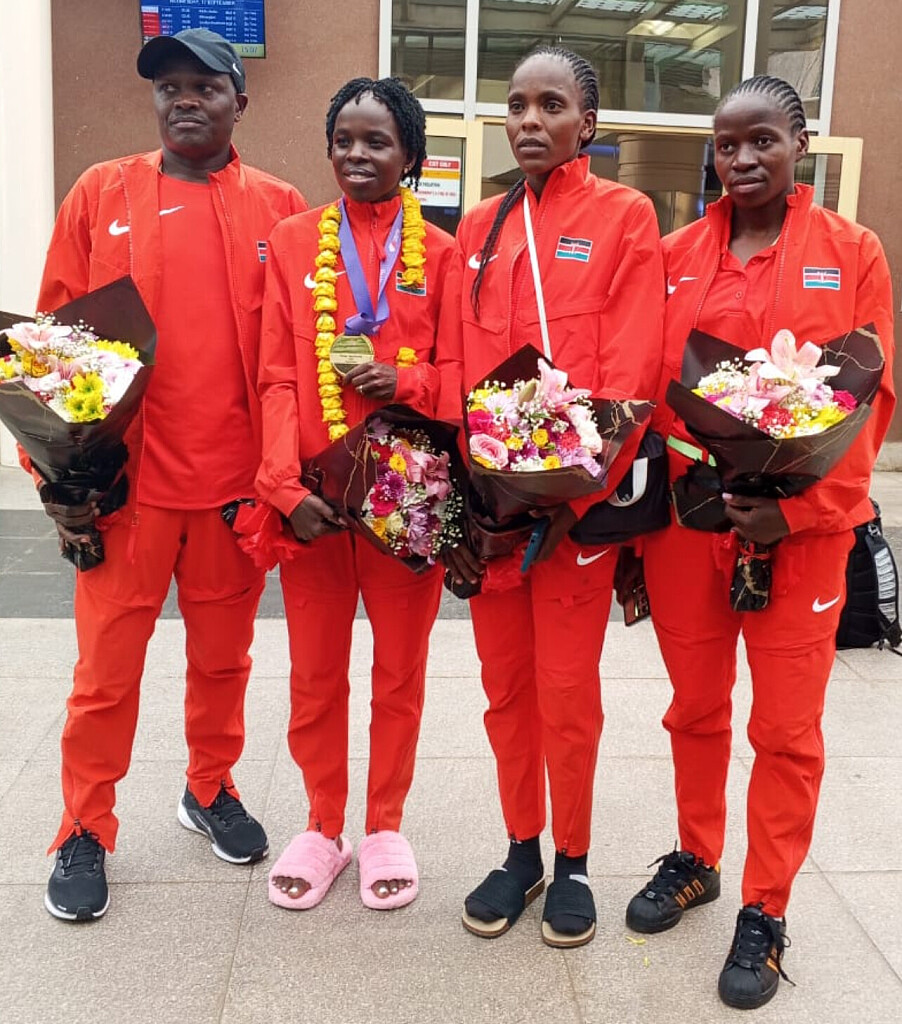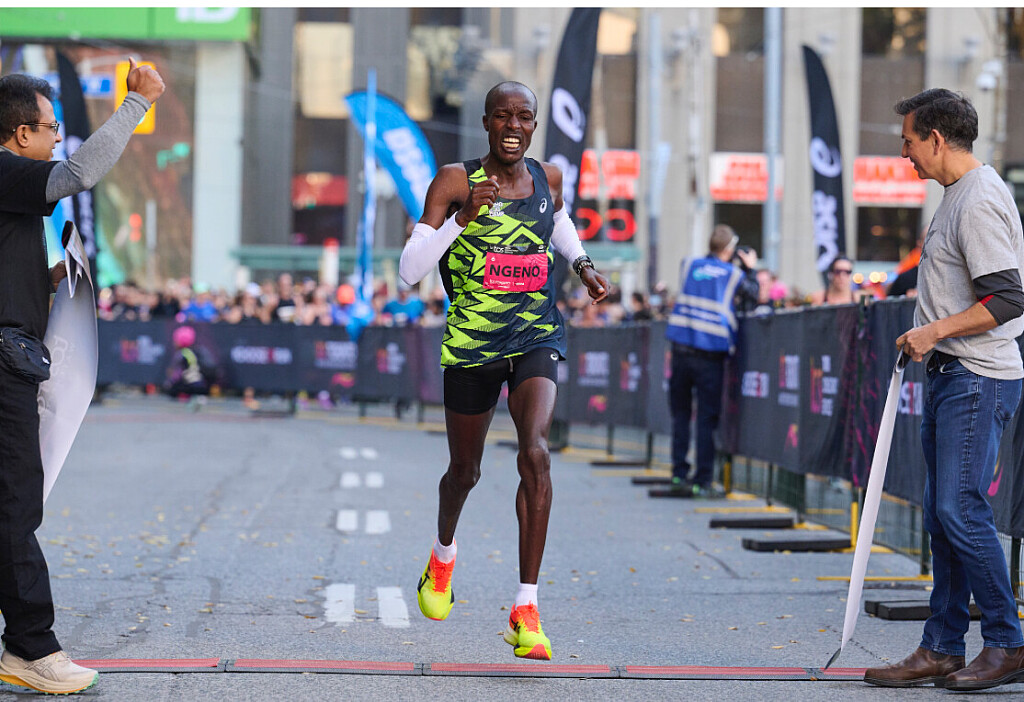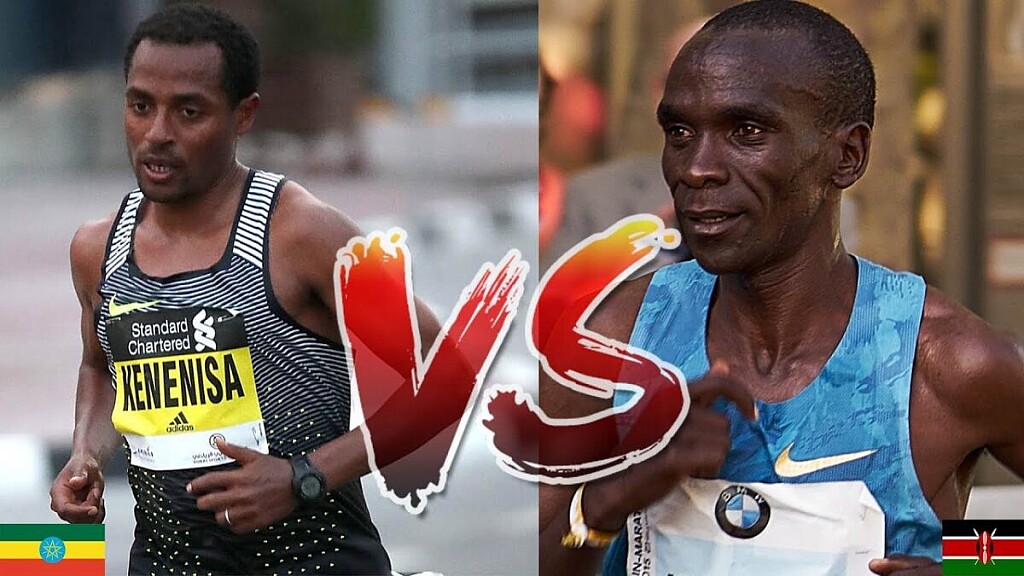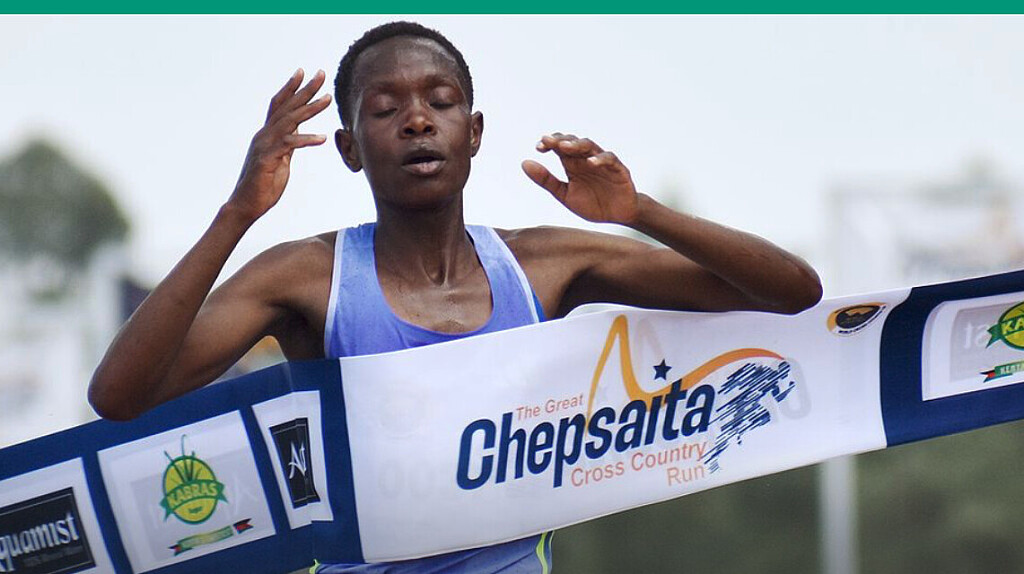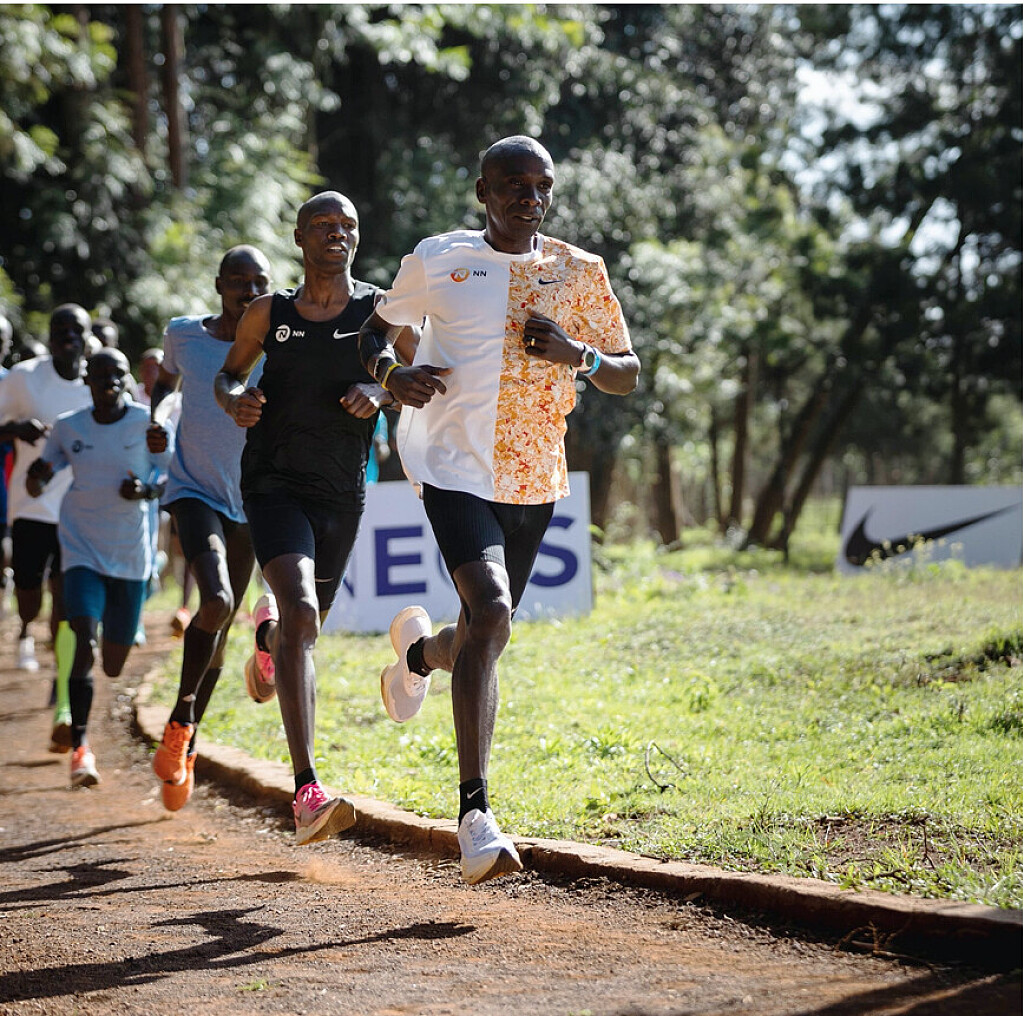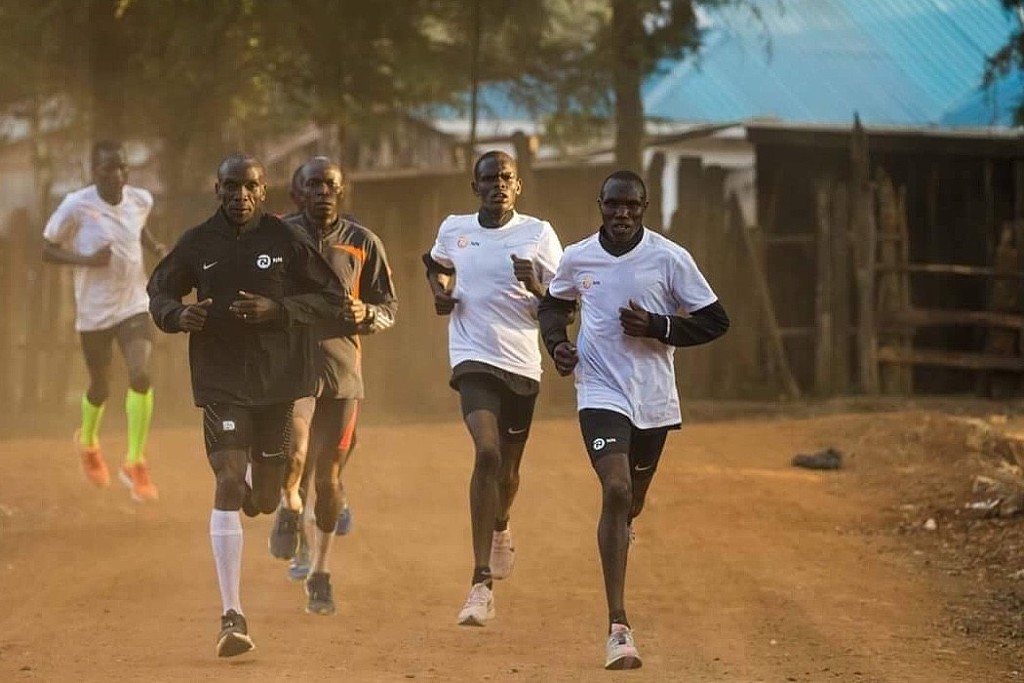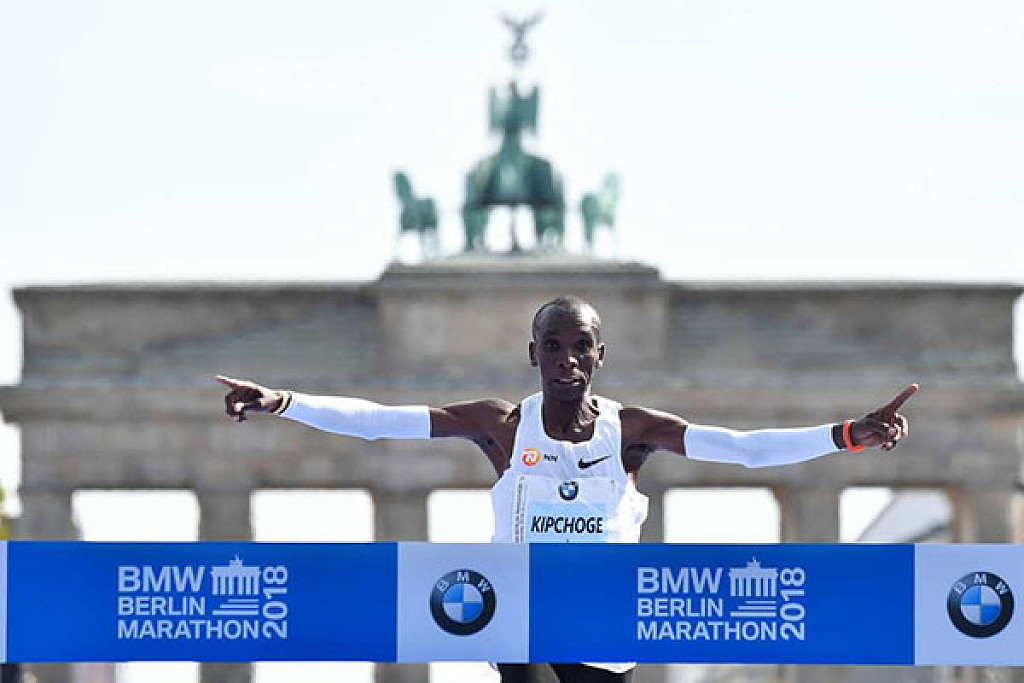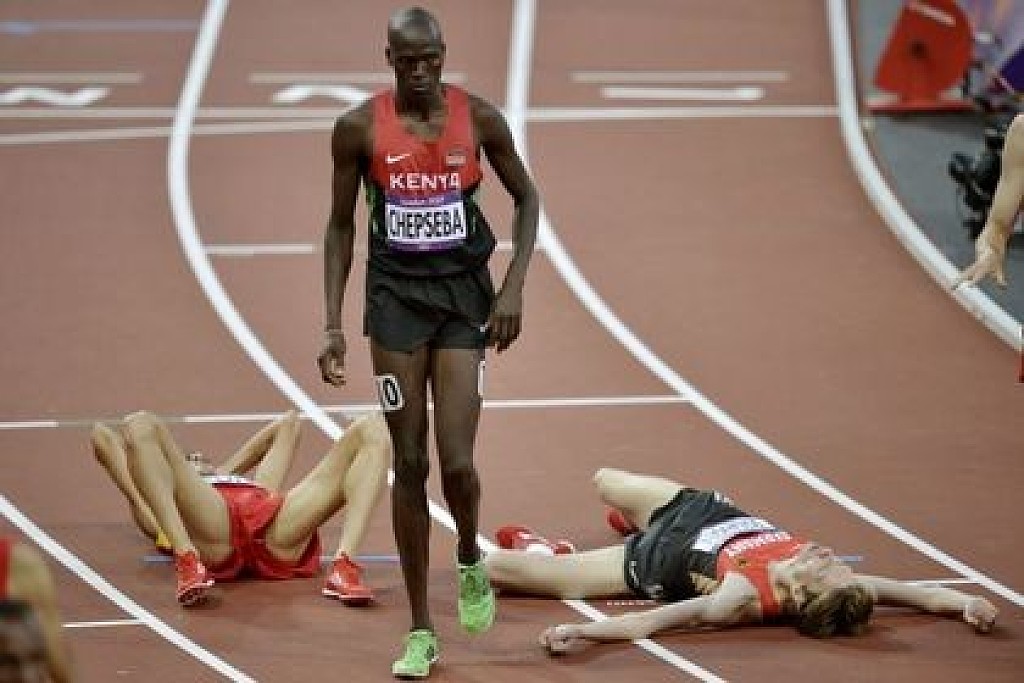Running News Daily
Running News Daily is edited by Bob Anderson. Send your news items to bob@mybestruns.com Advertising opportunities available. Train the Kenyan Way at KATA Kenya and Portugal owned and operated by Bob Anderson. Be sure to catch our movie A Long Run the movie KATA Running Camps and KATA Potato Farms - 31 now open in Kenya! https://kata.ke/
Index to Daily Posts · Sign Up For Updates · Run The World Feed
Articles tagged #home of champions
Today's Running News
Kenya’s World Championship Marathon Champion Peres Jepchirchir Returns to Hero’s Welcome in Nairobi
NAIROBI, September 16 – Kenya’s world championship marathon champion, Peres Jepchirchir, arrived home to a hero’s welcome following her golden run at the 2025 World Athletics Championships in Tokyo.
The 31-year-old touched down at Jomo Kenyatta International Airport (JKIA) on Tuesday morning, where she was greeted by traditional dancers, cheering fans, and a delegation of government and athletics officials. She was joined by teammates Jackline Cherono, Magdalene Masai, and Janeth Ng’etich, forming the first group of Team Kenya athletes to return from Tokyo. The reception was both a celebration of her individual triumph and a testament to Kenya’s enduring dominance in distance running.

A Marathon Masterclass in Tokyo
Jepchirchir’s victory was marked by patience, grit, and precision. Competing in soaring temperatures against a formidable Ethiopian contingent, she conserved her energy in the lead pack before making a decisive late surge to secure gold.
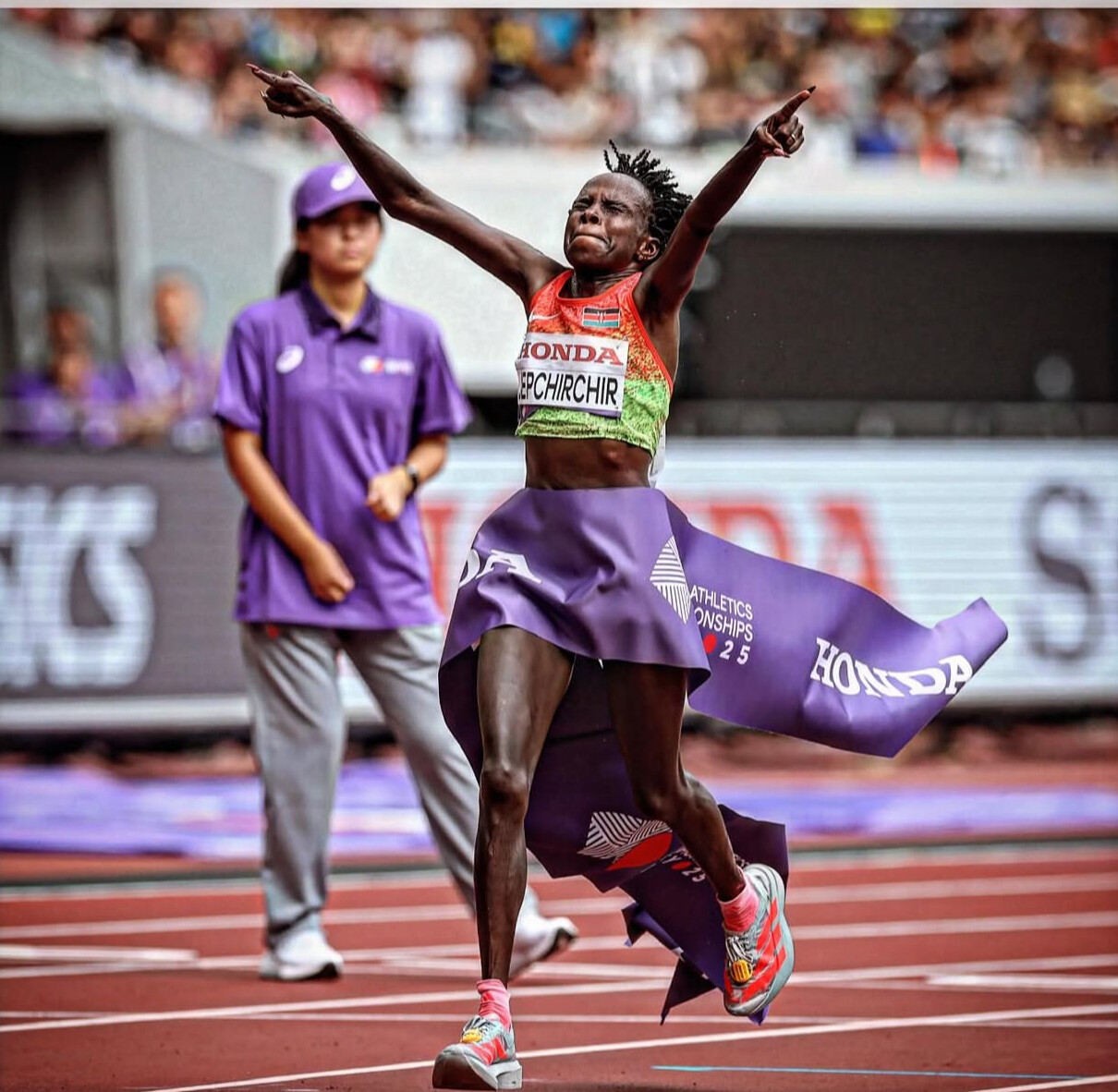
“From the beginning to the end, Peres believed in herself,” said long-distance coach Joseph Kahugu, who followed the race from the Tokyo course. “It was tough, especially against Ethiopia, but she showed her strength, fought hard, and delivered. We are proud of her.”
Her win reaffirmed her place among the greats: an Olympic champion, a two-time New York City Marathon winner, and now a world championship marathon gold medalist.
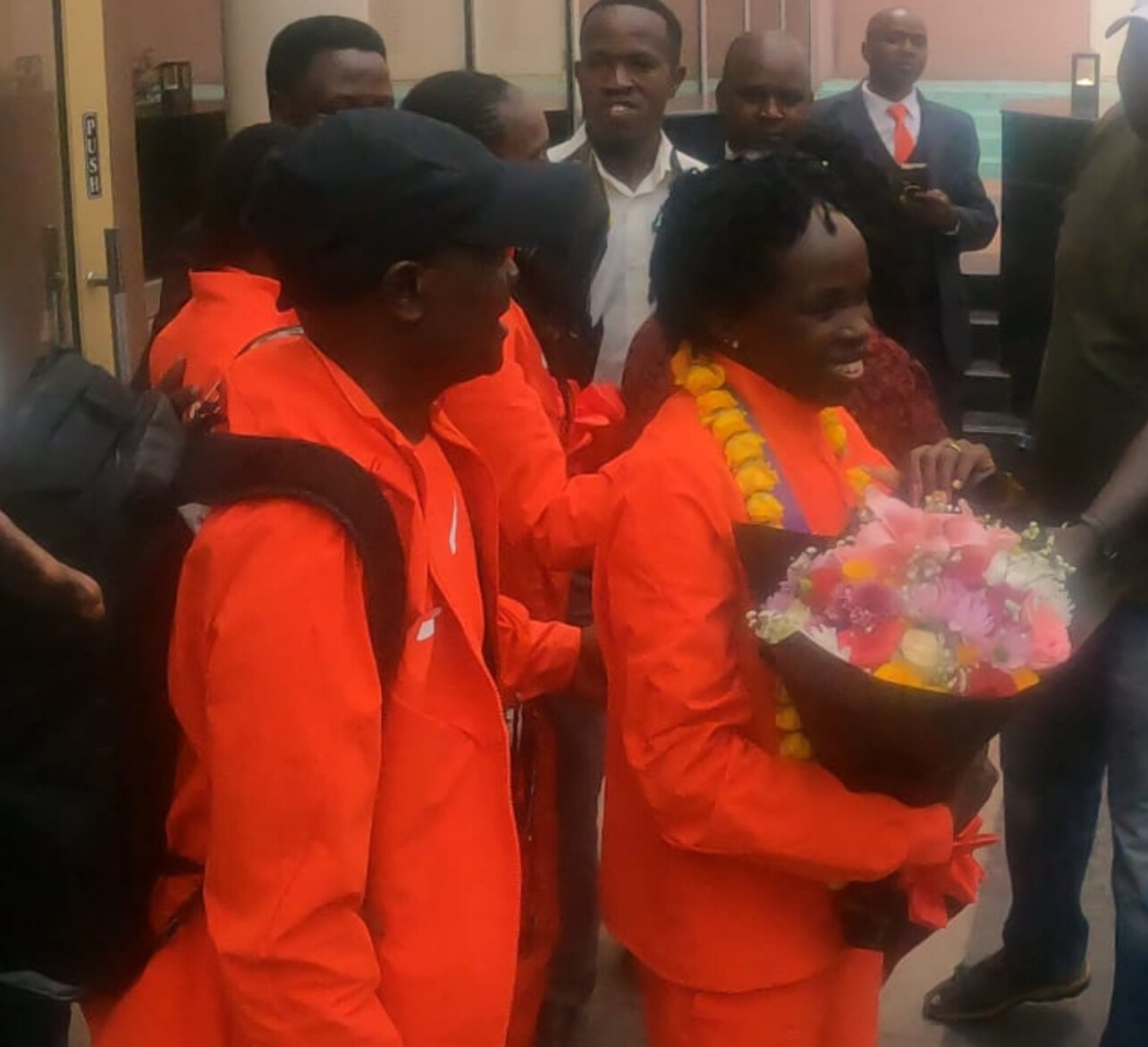
Government and Athletics Kenya Celebrate
Representing the Ministry of Sports, Jonah Towett assured the athletes of ongoing government backing.
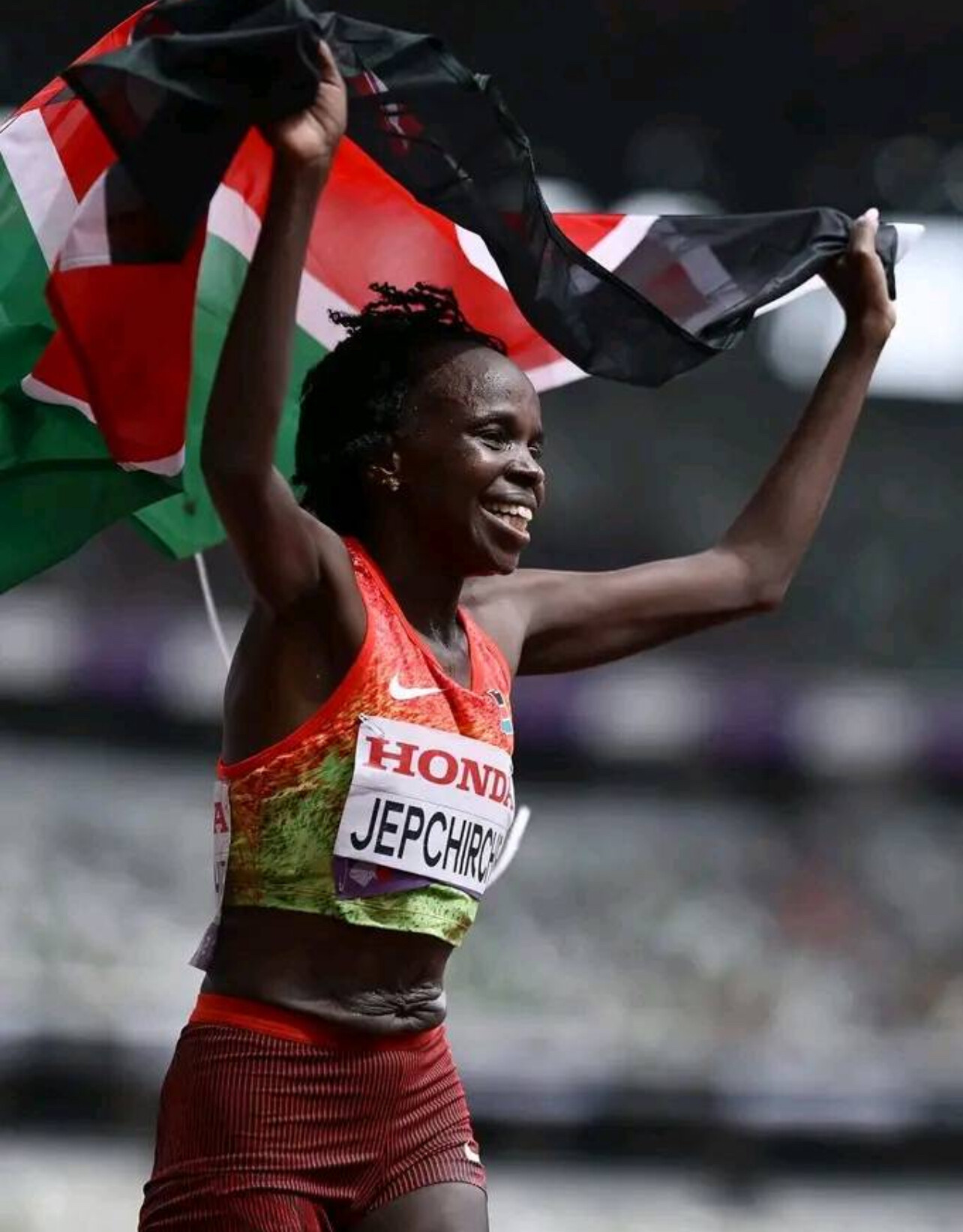
“This is a big day,” Towett said. “We are delighted to welcome our team back home. We congratulate them, especially our gold medalists, and assure them of our full support."
Athletics Kenya (AK) was equally visible at the welcome event, with officials led by Elizabeth Keitany. Keitany, praised Jepchirchir’s achievement and expressed optimism about the rest of Team Kenya still competing in Tokyo.
“We congratulate Peres for making Kenya proud,” Mary Keitany said. “Her victory is an inspiration, and we are confident more medals will come from Tokyo.”
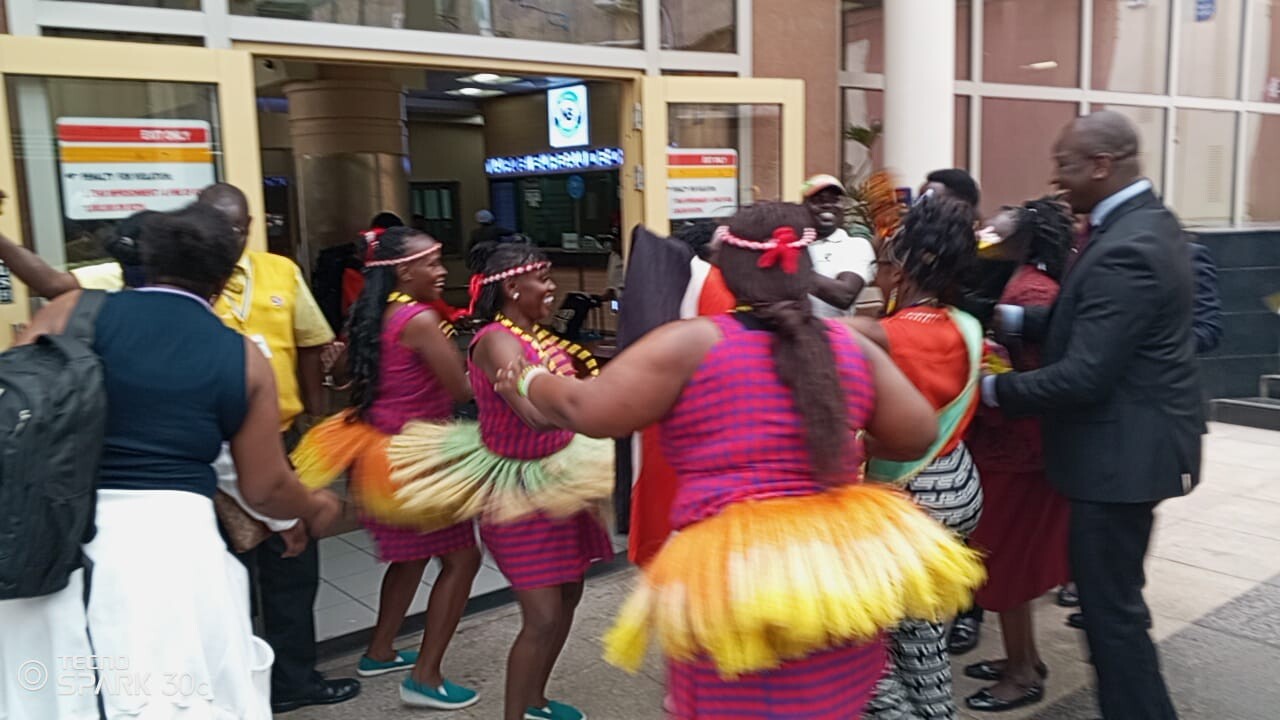
Preparing for the Heat
Coach Kahugu explained that Tokyo’s humidity posed a challenge, but adjustments paid off. “In Kenya, we didn’t train in such hot conditions. Once in Tokyo, we shifted to midday sessions to adapt. That preparation made all the difference,” he said.
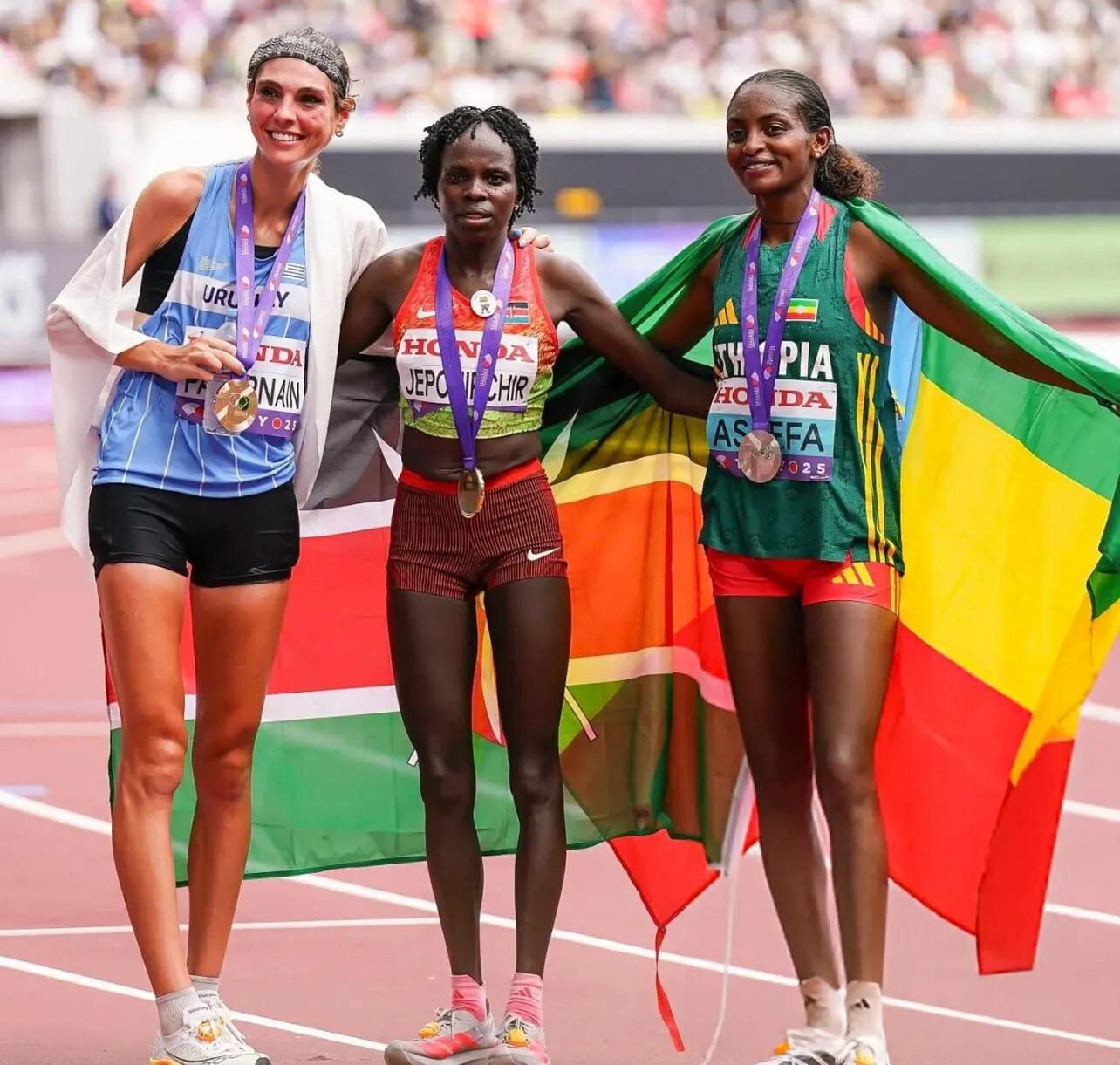
The strategy worked: Jepchirchir’s gold was supported by strong efforts from her compatriots, underlining Kenya’s strength in depth.
Global Spotlight on Kenya’s Legacy
Jepchirchir’s return has once again placed Kenya firmly at the center of the marathon conversation. Her triumph continues a proud tradition carried by icons like Catherine Ndereba, Tegla Loroupe, and Mary Keitany, while inspiring a new generation of runners.
“Kenya’s marathon culture is unmatched,” said one jubilant fan at JKIA. “Every victory like this strengthens our identity as the home of champions.”
Looking Ahead
While Nairobi celebrated, attention remains on Tokyo, where Kenyan athletes continue their medal hunt in the 1500m, 5000m, and steeplechase. Jepchirchir’s victory has set the tone, fueling hopes of more success.
A Champion Beyond the Finish Line
For Jepchirchir, the gold is more than just another medal. Having battled injuries and personal setbacks, her resurgence on the world’s biggest stage cements her as one of Kenya’s all-time greats.
From her beginnings in Kapsabet to victories in New York, the Olympics, and now Tokyo, Jepchirchir’s journey is one of resilience, faith, and belief. Her story continues to inspire athletes and fans worldwide — and her return home is a celebration not just of a single victory, but of a legacy still being written.
by Robert Kibet
Login to leave a comment
Kenya’s Dominic Ngeno Returning to TCS Toronto Waterfront Marathon
It speaks volumes about a marathon when podium finishers are eager to come back. Last year, Kenya’s Dominic Ngeno finished runner-up at the TCS Toronto Waterfront Marathon. Now, from his home in Iten, he confirms he will return for this year’s edition on October 19.
“It was an amazing race last year and I learned a lot,” he says with a grin. “The race was good. I am coming now to combat. I was so happy that the fans were cheering us all the way in the streets. It was so amazing.”
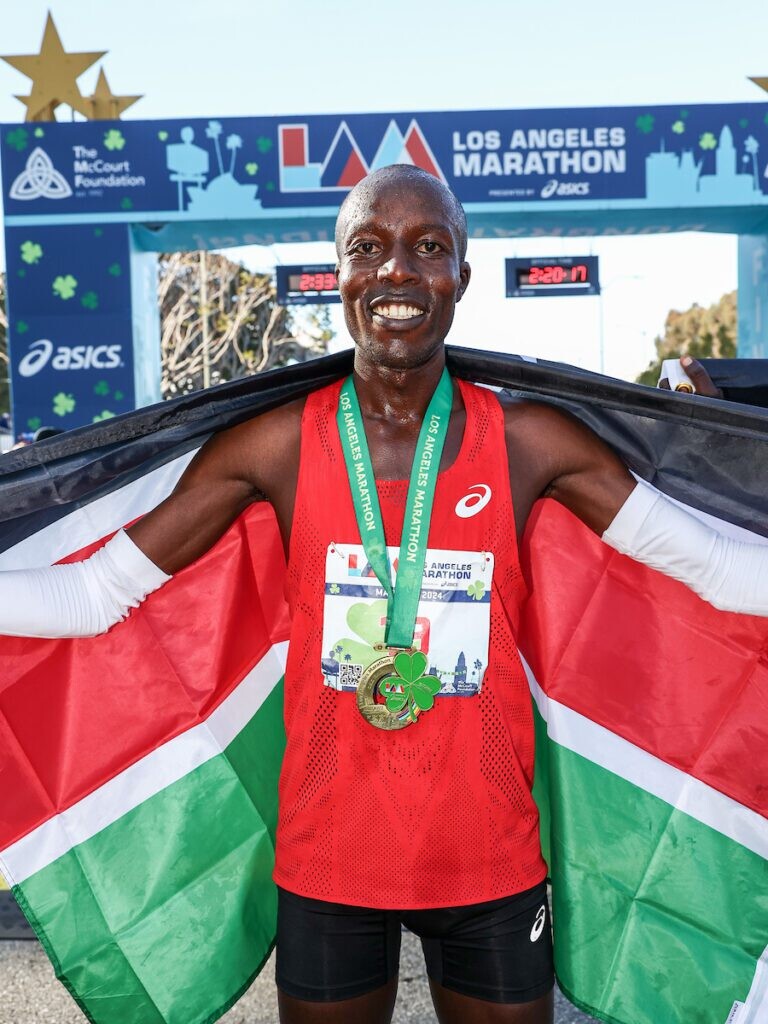
Finding his stride in Iten
In recent months, Ngeno has made some important changes. He left his training base in Kaptagat to return home to Iten, 2,400m above sea level — the famed “Home of Champions.” The switch has made him happier and, he believes, stronger. The proof came at the 2025 Paris Marathon, where he finished 5th in a new personal best of 2:06:37.
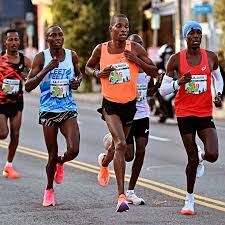
“I ran 2:06:37 in Paris and it is a hard course,” he explains. “It is not like Toronto. Last year I feared Toronto was tough because for a few years guys were running 2:09 or 2:10. But when I finished, I saw it was good. Paris compared to Toronto? Toronto is a nice course.”
Training with purpose
Speaking via WhatsApp video, he animatedly describes his training and credits his group of six training partners with pushing him forward. Just before the interview he had run 20km in the evening, then 10km the following morning, with a demanding session of 15 x 1km intervals planned later that day. Every couple of weeks he adds a 40km long run.
“When I am not training, I am resting in the compound — just sleeping,” he says with a smile. “Sleeping is part of the training program. After lunch I sleep, then go for training. When I come back, I take tea and wait for dinner.”
Like many Kenyan athletes, he still makes time to follow English Premier League football.
“Yeah, I am a big fan of Chelsea — the Blues,” he laughs. “My favourite player used to be Didier Drogba, but now it is Cole Palmer.”
A latecomer with big dreams
Ngeno turns 28 on September 3rd, still relatively new to the marathon. After high school he played soccer, then studied in Eldoret for two years, where he met some of Kenya’s top runners. But it was a chance encounter at a 2021 cross country meet with Amos Kipruto — the 2022 London Marathon champion and 2019 world bronze medalist — that shifted his focus.
“We had some small interactions,” Ngeno recalls. “He really inspired me because he didn’t run so many half marathons, and his dream came true after he started running marathons. That inspired me. I ran only two half marathons before deciding to be a marathoner full time.”
Building a future beyond running
Professional running offers him a chance to secure a brighter future. A contract with Asics helps, but he is also investing wisely.
“There is life after running so you need to invest whatever you get,” he says. “Now I have a small business — I have electronics stores and I am also farming. After running I will work with my family and grow that. I have shops and people who work for me. Whenever someone needs something like a television, they can go there.”
Looking ahead
Some of the greatest marathoners — Haile Gebrselassie, Kenenisa Bekele, Eliud Kipchoge — have thrived well into their late 30s. Ngeno believes he has another decade at the top and is motivated by the possibility of representing his country.
“First, I love running, and because I love running I want to run my best and change my life,” he declares. “I want to be the best. I have that dream of running for Kenya. This year when they were selecting the team I was not far from selection. I believe soon I will run for Team Kenya — maybe at the World Championships or Olympic Games.”
For now, his focus is firmly on the TCS Toronto Waterfront Marathon, where he aims to take on a world-class field and turn last year’s second place into victory.
by Paul Gains
Login to leave a comment
TCS Toronto Waterfront Marathon
The Scotiabank Toronto Waterfront Marathon, Half-Marathon & 5k Run / Walk is organized by Canada Running Series Inc., organizers of the Canada Running Series, "A selection of Canada's best runs!" Canada Running Series annually organizes eight events in Montreal, Toronto and Vancouver that vary in distance from the 5k to the marathon. The Scotiabank Toronto Waterfront Marathon and Half-Marathon are...
more...Kenya vs Ethiopia What Sets Their Runners Apart
When it comes to distance running, no two countries are more dominant—or more frequently compared—than Kenya and Ethiopia. From 5Ks to marathons, athletes from these East African nations consistently top podiums and rewrite record books. But while the results may look similar, the paths to victory are often quite different.
Altitude Advantage, Different Terrains
Both Kenya and Ethiopia benefit from high-altitude environments that naturally boost endurance. Kenya’s top training hubs, like Iten and Eldoret, sit between 7,000 and 8,000 feet. Ethiopia’s Bekoji and Sululta offer similar elevations. But terrain matters too: Kenya’s roads are often red clay or uneven gravel, ideal for building strength and resilience. Ethiopia’s runners more frequently train on hills and mountain trails, with steeper and more demanding climbs integrated into daily runs.
Training Philosophies Diverge
Kenyan training is rooted in simplicity and rhythm. Athletes often meet for large group sessions, with a strong focus on tempo runs, long-distance efforts, and unstructured fartleks. The vibe is community-oriented and competitive—if someone surges, the group follows.
In contrast, Ethiopia’s elite training tends to be more individualized and coach-driven. Athletes follow structured schedules with clearly defined paces, recovery sessions, and high-intensity track workouts. The approach is more scientific, and recovery days are strictly observed.
Daily Life and Recovery
Kenyan runners typically live together in camps, waking early to train, followed by long periods of rest. A second run often comes in the late afternoon, and the lifestyle emphasizes minimal distractions.
Ethiopian runners may train in smaller groups and return home between sessions. There’s more variety in how the day is structured, though the focus on discipline remains.
(Photos) Kenyan Training in Iten and Eldoret
1. Mass Training Run in Iten
A striking image capturing a large group of Kenyan runners during a typical morning session on the red dirt roads of Iten, known as the “Home of Champions.”
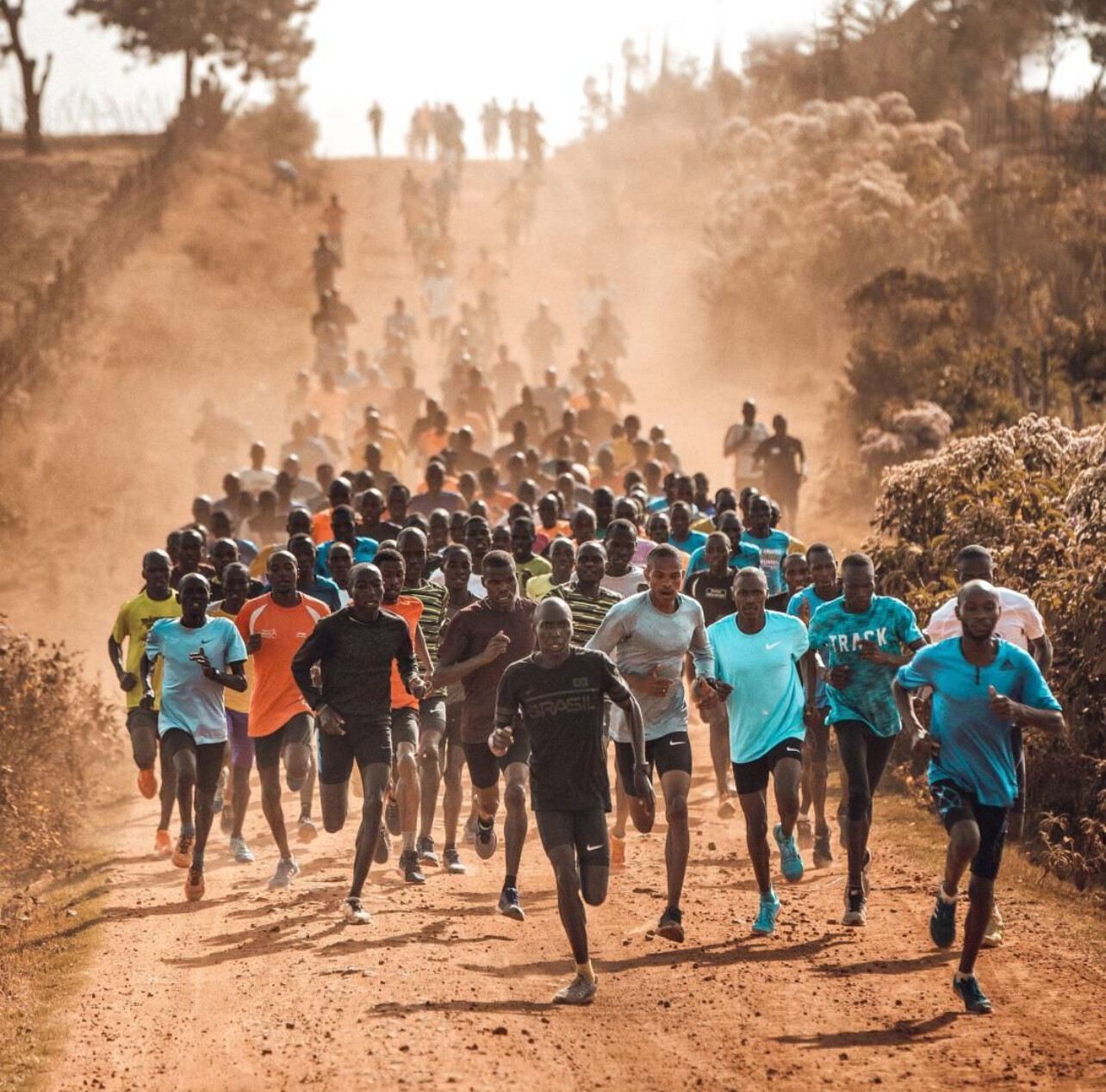
2. Track Workouts in Eldoret
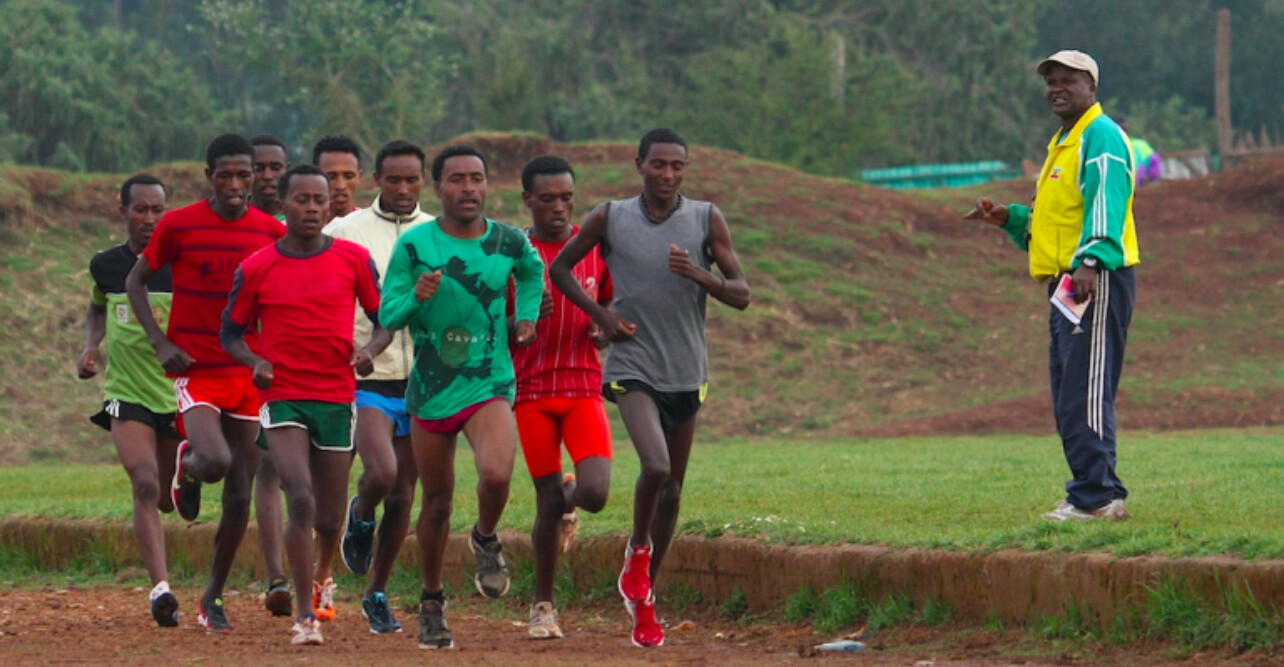
Kenyan marathon runners engaging in interval training at the athletics track in Eldoret, highlighting their emphasis on group cohesion and endurance.
(Photos) Ethiopian Training in Bekoji and Sululta
3. Group Training in Bekoji
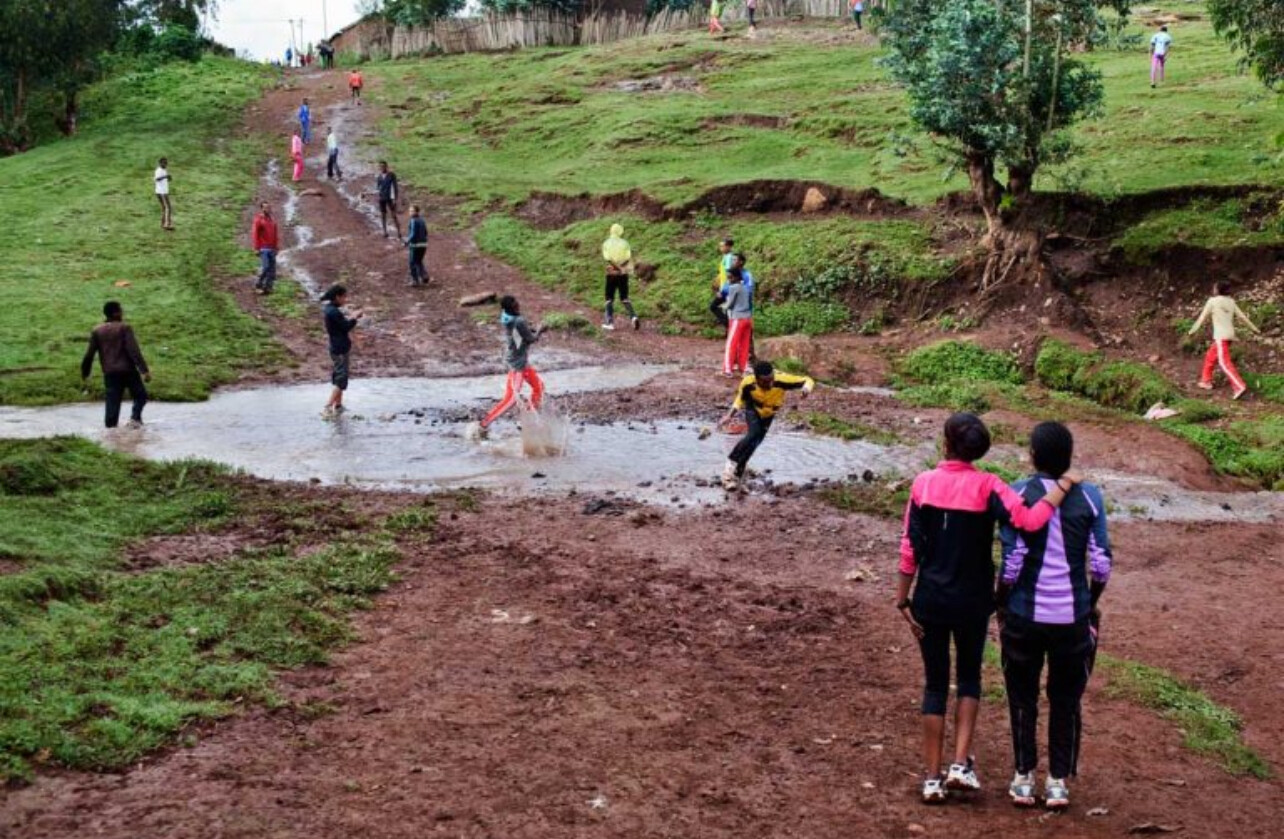
A glimpse into a training session in Bekoji, Ethiopia, showcasing runners on a dirt track, emphasizing their structured and coach-led routines.
4. Trail Running in Sululta
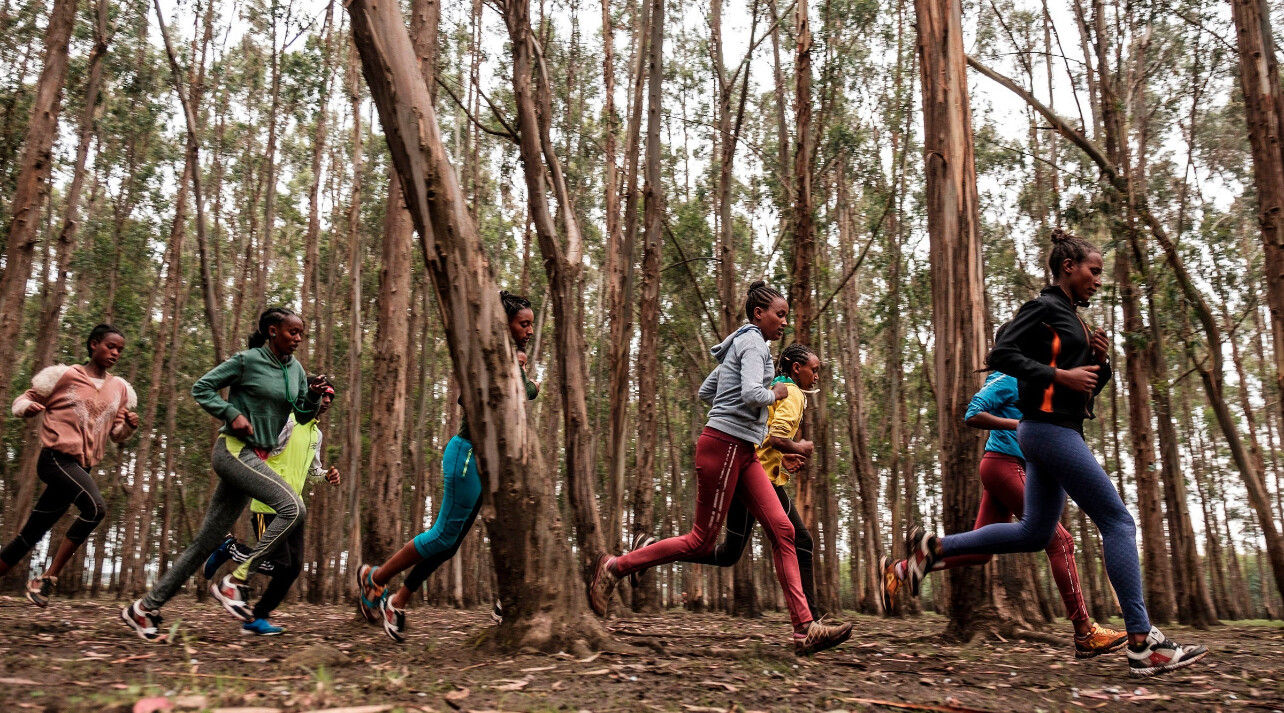
Ethiopian athletes navigating through forested trails in Sululta, reflecting their focus on varied terrains and natural environments.
Fueling for Success
Diet is another point of contrast. Kenyan athletes often eat ugali, a maize-based dish, with sukuma wiki (collard greens) and beans. Meals are consistent, simple, and heavy on carbohydrates. Hydration includes local teas and water, with little emphasis on supplements.
In Ethiopia, injera (a sour flatbread made from teff) is the foundation, served with protein-rich stews like shiro or doro wat. Teff is rich in iron and slow-digesting carbs—making it a valuable fuel for endurance.
Cultural and Coaching Influence
In Kenya, many athletes are inspired by runners from their own village or region—legends like Eliud Kipchoge or David Rudisha have inspired thousands. Training is often passed down through generations informally.
In Ethiopia, there’s a more centralized coaching system and support from the national federation. Greats like Haile Gebrselassie and Kenenisa Bekele have helped shape a more formal pathway from local clubs to the world stage.
Different Roads, Same Finish Line
Despite the differences, the results speak for themselves: both countries continue to dominate. Kenya may have the edge in the marathon, while Ethiopia consistently excels in 10K and track events. Together, they’ve redefined what’s possible in distance running.
by Boris Baron
Login to leave a comment
Chekwemoi and Chebolei claim victories in Chepsaita
Ugandan teenager Loice Chekwemoi and Kenya’s Samwel Chebolei Masai were unrivalled at the Great Chepsaita Cross Country – a World Athletics Cross Country Tour Gold meeting – held on the outskirts of Eldoret on Saturday (7).
Pre-race favourite Chekwemoi, aged just 17, won the women’s race by more than 80 seconds, while 23-year-old Chebolei had a tighter contest in the men’s event.
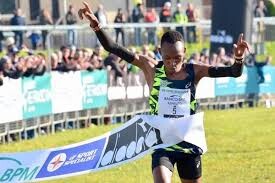
Ethiopian teenager Shimeles Mekides Molla put in an early surge after the first 2km loop of the women’s 10km race with Chekwemoi and Abigael Chepkoech trailing close behind.
Molla’s lead was short-lived, though, because Chekwemoi moved to the front and opened a gap steadily. It wasn’t long before the African steeplechase champion was running alone out in front with just the thousands of spectators for company.
The Ugandan teenager went on to finish in 34:32, while Molla was almost a minute-and-a-half behind, clocking 35:57 for the runner-up spot. Celestine Biwot completed the podium in 36:43.
“I couldn’t believe that I could win in the home of champions but I told myself I am also a champion and I have to fight for it,” said Chekwemoi. “To be a champion is not easy but I see progression and I am working hard to make sure I qualify for the World Championships in Tokyo next year.”
By contrast, there were 10 athletes running close together at the end of the first lap in the men’s race. That pack was soon reduced to five men, including world U20 cross-country bronze medallist Matthew Kipkoech Kipruto, 2019 African Games 5000m champion Robert Kiprop, and Samwel Chebolei, who was fifth at this year’s World Cross, contributing to Kenya’s team gold medal.
Heading into the fourth lap, Kipruto led from Kiprop and Chebolei. Kipruto’s challenge faded in the closing stages, though, while Chebolei proved to have the stronger finishing kick. He crossed the line in 30:49 to win by nine seconds. Kiprop took second place, improving on his fourth-place finish from last year. Pre-race favourite Kipruto was third in 31:12.
“I had to fight because there were a lot of good athletes in this race, it was not easy,” said Chebolei. “After the third lap, we still felt energetic and the three of us decided to drop the rest and the maths worked for us. I am hoping to build up from here and represent Kenya in Tokyo.”
Kevin Kiprop Biwott won the U20 men’s race, beating world U20 5000m champion Andrew Kiptoo Alamisi by 17 seconds.
Cynthia Chepkurui, who was ninth at the African Cross Country Championships earlier this year, this time emerged as the winner in the U20 women’s 6km race in 21:17.
Several of Kenya’s leading athletes, past and present, attended the Great Chepsaita Cross Country, including Eliud Kipchoge, Faith Kipyegon, Benson Kipruto, David Rudisha, Julius Yego and Janeth Jepkosgei.
by World Athletics
Login to leave a comment
What it takes to become a Kenyan distance champion
For several generations now, Kenya has produced many of the world’s greatest distance runners.
Many athletes from elsewhere in the world, meanwhile, have tried to tap into the secrets of Kenya’s success as they try to play catch-up – quite literally – with the east African nation that continues to churn out global medallists and world record-breakers.
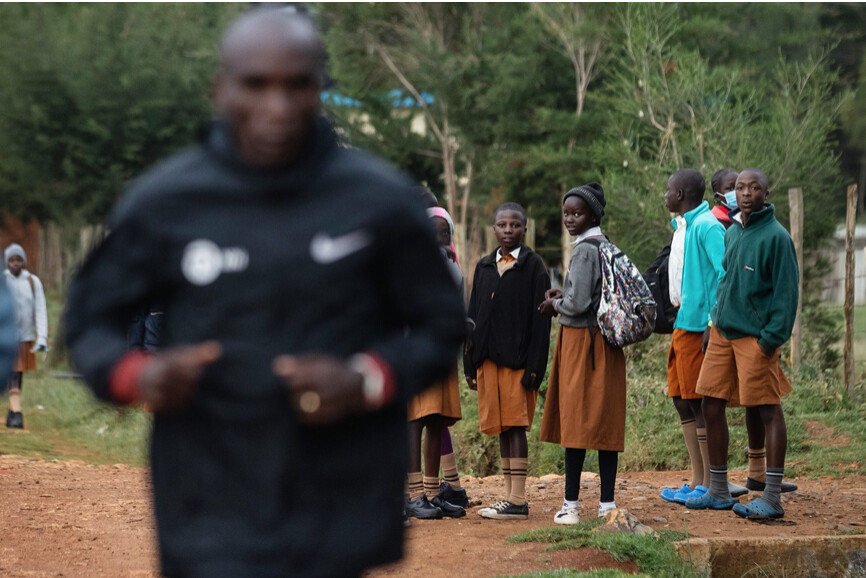

The truth is, there is no one single reason why Kenya is so dominant in distance events. It’s more down to a combination of factors, many of which were explained during a recent trip to the NN Running training camp in Kaptagat, about 24km east of Eldoret, where the likes of Eliud Kipchoge trains for 11 months of the year.
A way of life
There are few countries where people live and breathe athletics, and where the No.1 Olympic sport can claim to be more popular than football, filling entire stadiums even for age-group championships.
And while Kenya isn’t the only country in the world where kids run long distances to get to school, running has a whole different meaning to many people in the country.
Running is something that comes naturally to us as it’s something that has been part of our lifestyle since we were born,” says three-time world half marathon champion and two-time New York City Marathon champion Geoffrey Kamworor. “As a kid, I used to run from home to my school three kilometres away back and forth each day, so you end up running sometimes 12 kilometres a day as a teen without even realising it.”
Beyond being a means to an end, there is also a genuine love for running among the Kenyan population.
“As a kid, I would always go and watch athletics competitions when not at school and I enjoyed watching people competing,” added Kamworor. “It awoke my passion for running, especially seeing people cross the finish line and winning a trophy. In high school, it was always a fun and proud moment to represent your class and win a cup. I found it very encouraging.”
Having running embedded into day-to-day life sets Kenya apart from many other nations. But it’s just one of the many reasons why it is known as being the ‘home of the champions’.
Genetics
Simply running to school each day doesn’t automatically turn everyone into a world-class athlete. Genetics, as it does for every elite athlete, likely play a significant part.
Many people in the Rift Valley, where most of Kenya’s top distance runners originate, belong to the Kalenjin tribe. When compared to other Kenyan tribes, Kalenjin people are often described as having good natural running attributes: namely lean bodies and long legs.
Kipchoge, for example, isn’t particularly tall (1.67m / 5ft 6in), but the muscles on his legs are incredibly lean, his body fat percentage is low, and the strength in his feet make it appear as though he bounces along the grass.
But attributing all of Kenya’s success to just their genetics would be a gross over-simplification.
Conditions
Another element that helps Kenyan athletes in their training and preparation is the unique climate and surroundings in this part of the country. It also probably explains why there are so many training camps between Kaptagat and Iten, and why some people refer to it as the ‘Hollywood of elite runners’.
This region is located at 2500 metres above sea level, which, given the lack of oxygen, helps athletes produce a higher concentration of red blood cells and haemoglobin when training. This, in turn, gives runners an advantage when they return to lower altitudes to race.
The Eldoret region is also full of endless forests and dirt roads for athletes to use when running, while the area also enjoys a temperate climate with daytime temperatures ranging between 22-26C (68-78F) throughout the year, dropping to 10-12C (50-53F) at night time. That, combined with the good air quality, makes the area something of a distance-running paradise.
But as Kenya’s economy continues to develop, so do the local villages and the wider region, meaning many of the local dirt paths are now being made into proper roads – which is great for facilitating transport and access from other points of the country, but less so for athletes seeking a run-friendly surface.
Athletes are adapting well to this evolving environment, though, while remaining in close contact with nature. The Kalenjin community, Kipchogeand Kamworor included, are running many tree-planting initiatives. “We evolve in a very natural environment which is a great advantage when it comes to training,” says Kamworor.
Patrick Sang, the 1992 Olympic silver steeplechase medallist and head coach at the Kaptagat training camp, explains how the new generation of running shoes can help counter the effects of running on harder roads.
“New running shoes help a lot because athletes can now do a lot more training on a hard surface and still recover on time to do their next hard session,” says Sang. “Overall, you can get more work done to help improve performance.”
Sleep, eat, train, repeat
Most world-class athletes are fully committed to their sport, but the elite runners at the Kaptagat training camp in particular take dedication to a whole new level.
Many of these athletes – including young mothers such as two-time Olympic 1500m champion Faith Kipyegon – have children who are at home during the week so that they can entirely focus on their training at the camp.
“Of course, it’s very hard but that’s the only way to be fully dedicated to being the best athlete you can and avoid any distraction,” said Kipyegon.
When not running, athletes at the Kaptagat training camp are focused entirely on other elements of their training, namely recovery and nutrition.
“When you are at the camp, your sole focus is on running and you are not distracted by anything else,” says Kamworor, father to five children, including young triplets. “You are away from your family, your wife and your kids during the whole week, and that makes you take your training very seriously as you are making sacrifices to achieve your goals. That’s the only way to be focused 100% on running and to give your very best.”
As in any walk of life, hard work and having the right mind-set are key to success. Kipchoge might be the most successful athlete at the camp, but Sang says that’s not just down to his talent. “Eliud isn’t the most gifted athlete within his training group but certainly the most dedicated,” Sang says of Kipchoge, who is always the first one ready for training and the last one to leave.
In an average week, athletes at the Kaptagat camp do one long run of 30km (once a month it will be 40km), which usually takes place early on a Thursday morning. Typical track sessions, meanwhile, would be something like 8x1600m (each rep completed in 4:40) and 8x400m (at an average of 65 seconds) on their local 380m cinder track.
“Have you seen him?” Sang says when watching Kipchoge train. “This guy is a machine.”
Athletes are religious in their approach to punctuality and producing their best effort in training. And other local athletes from outside the NN Running team are welcome to join in the sessions, provided they arrive on time. After all, no one wants to be playing catch-up with the likes of Kipchoge and Kamworor.
Community
The Kaptagat training camp is run entirely by the 25 athletes who live there for 11 months a year from Monday to Saturday morning before going back to spend quality time with their family, often in the big city of Eldoret. In and around the 12 training runs they do in a typical week, the resident athletes to everything at the camp.
“If you look at life at the camp, the one making bread is an athlete, the cleaning is done by the athletes, the one doing shopping for the camp is an athlete,” says Sang. “You don’t want athletes to live on another island.
“The whole idea is to make sure these athletes become well-rounded people. You wouldn’t want to help someone become a great athlete who lacks social skills or is out of touch with society.”
Kipchoge, whose wife and three children live just 45 minutes away from the training camp, could easily go and spend time with his family during his time off, but instead he chooses to stay at the camp with the rest of the group, monastically isolated from the rest of the world.
Kipchoge is rarely bored, too. When he’s not training or resting, he will be reading or working at the camp or reading.
The sense of community extends to caring about the environment. Every athlete at the camp gets a tree planted at the entrance as a welcome gesture and to symbolise their connection to nature. Some special guests to the camp – including Ethiopian legend Haile Gebrselassie – have also had a tree planted for them in Kaptagat.
Occasionally, athletes at the camp will give each other lessons, or they will engage in real debates around serious issues, helping them develop holistically as people.
Simplicity
Far away from the latest technological innovations you often hear about in other parts of the world, daily life at the camp is basic.
Upon entering the gates at the Kaptagat training camp, the 380m cinder track is located on the left. It has a slight incline on the first bend and a couple of cows as spectators, but it meets all their needs.
“A synthetic track isn’t needed for what we do and the way we train,” says Marc Roig, a former international runner from Spain, who now works as a jack of all trades for NN Running, acting as a fitness coach, physio, runner, mentor and pacemaker. “If our athletes need a synthetic track, they can go to the one in Eldoret an hour away.” In fact, there are just four synthetic tracks in the whole of Kenya, but it’s clearly not a barrier to producing top athletes.
The runners at the camp rarely lift weights or spend time stretching, but twice a week they will do core strength sessions. Instead of water, they drink mursik – a nutritious fermented milk – in the morning and Kenyan tea in the afternoon. And not a single drop of water during their 30km long run. “That’s okay,” says Sang. “They don’t need it.”
Within the camp itself, there is a TV room with a small library corner with a few books there for the athletes, a living room for their meals, the dormitory (one for women and another for men), a basic gym comprising a bike, a treadmill, some elastic bands and a light weightlifting bar (with maximum 40kg available) and a big blue plastic drum outside used for ice baths.
It’s all quite rudimentary, but they don’t need more, and it seems to work.
The only visible ‘luxury’ – aside from the eco-friendly solar panels to get hot water – is that Kipchoge has his own bedroom. But even the king of the marathon does his fair share of the chores. He prepares tea for other athletes, and there’s a strict cleaning schedule that all athletes must stick to.
“I think that when you stop leading a simple life, your mind-set loses contact with the outside world and you lose your focus on your actual goals,” says Kipchoge. “At this point, you run the risk of forgetting about the really important things in life.”
Life at the camp is minimalistic, but nobody complains. Indeed, this simplicity is what defines them and enables the athletes to keep their focus and remain humble about who they are, where they come from and what they are here for.
Hollywood of running
To be the best, you need to surround yourself with the best – which is another reason why the Rift Valley continues to produce champion athletes.
The likes of Kipchoge, Kamworor and Kipyegon are true A-listers, but Kaptagat is filled with talented athletes who have achieved podium finishes at major championships and big city marathons.
Roig, who has a 2:18:05 marathon PB, moved to Kenya several years ago. “When I take my kids to school, I feel ashamed saying I am a runner as many of the dads there have 2:05 marathon PBs,” jokes Roig, who is now the race director for the Valencia Marathon. “There is even a mother at the school who has a PB similar to mine!”
But the Kaptagat camp isn’t the only leading training venue in the area. Iten, a small town at 2400 metres above sea level about an hour north of Kaptagat, is often referred to as the ‘home of champions’ or the ‘Hollywood of distance running’.
One of the drivers used for NN Running Team’s trip to Kenya, for example, was a former 1:06 half marathon runner. His wife, meanwhile, was a 2:21 marathon runner who finished second at the Rotterdam Marathon a couple of years ago. His neighbour is Emmanuel Korir, the Olympic 800m champion, and he is good friends with Joyciline Jepkosgei, the multiple world record-breaker and 2021 London Marathon champion.
Abdi Nageeye, the Olympic marathon silver medallist, also happened to be in Iten at the time of the trip. While ferrying around members of the media, the driver passed by a gas station named ‘Oslo’, which is one of many local businesses owned by Vivian Cheruiyot. The 2016 Olympic 5000m champion opened the station after winning at the Oslo Diamond League meeting.
One of the biggest training venues in Iten is the High Altitude Training Centre founded by multiple world half marathon champion Lornah Kiplagat, who herself is part of a highly successful family of runners, including Sylvia Kibet, Hilda Kibet and Susan Sirma. Many international athletes, including the likes of Mo Farah and Paula Radcliffe, have previously stayed there, while former steeplechaser Bob Tahri of France opened his own training centre in Iten a few years ago.
The Rift Valley – Iten and Kaptagat in particular – is like nowhere else on earth. Everybody knows a champion who is friends with another champion, who is the neighbour of another champion.
It’s yet another way – and one of the many – of becoming a great runner.
by World Athletics
Login to leave a comment
Eliud Kipchoge says he handles pain by smiling - Part two of a three part series on the King of the Marathon
The King of The Marathon Part Two: an inside look into the life of Kenya's Eliud Kipchoge. He began his move into road running in 2012 when he clocked 59:25 for the half marathon. In 2013 Eliud ran his first marathon when he won the Hamburg Marathon clocking 2:05:30, setting a new course record.
In 2016 he won the gold medal in the marathon at the Rio Olympics. He has won 10 out of the 11 marathons he has run. Wilson Kipsang beat him in 2013 in Berlin when setting the world record.
We Eliud trains in Eldoret, the home of Champions. His humbleness is seen when training with athletes. Eliud keeps a low-profile and even does house chores in camp like washing toilets, utensils, cutting grass and cleaning the dining hall. He uses public buses or bodaboda to travel despite having good cars.
He has earned a lot of prize, bonus and sponsorship money from running especially since he moved to the road. However, money hasn't changed his character. He says, "An athlete with 50 million Kenyan shillings ($500,000US) in his bank account can brag, but a farmer who uses the same amount to plant wheat is not even noticed as he walks around town."
Eliud loves the simple life and when he travels he arrives without many people realizing it. He loves his Nike shoes and is comfortable with NN running and with his mentor and neighbor Patrick Sang. During the Nike project, he almost broke the two hour mark clocking 2:00:23 for the full Marathon. Yes, the conditions were perfect and he was paced like in a time trial but his body ran the distance.
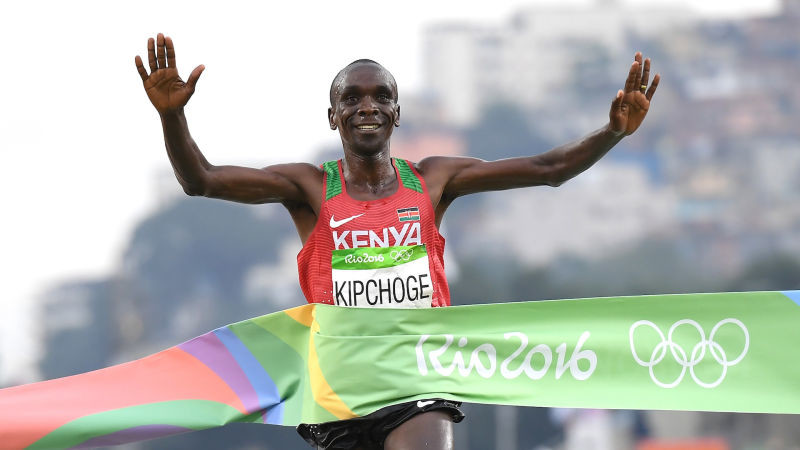
He puts in a lot of hardwork, discipline and good training. He also eats a healthy diet. Before he lined up to run the Berlin Marathon this was the kind of workouts he was doing. 8x1600 (recovery 1:30) + 10x400m (recovery 45 seconds) in Eldoret altitude 2200m (7200 feet) above sea level. His 1600m times were: 4:35, 4:33, 4:32, 4:34, 4:33, 4:32, 4:33, 4:33. His 400m times were: 62, 63, 63, 62, 62, 62, 61, 62, 61, 60.
He always does speedwork on the track wearing racing shoes with other fast athletes like Kamworor, Brimin kipruto and Conselsius. "You can't train alone because you need others to push you higher to reach your best limit," Kipchoge told me last month at Kabarak university. No marathoner has been more dominant in the marathon than Kipchoge.
The 5'6" 115 pound Eliud has never sustained a serious injury because he listens to his body and eats a healthy diet. Even the greatest runners have days when they have a strained muscle or an upset stomach kept them from winning but not Kipchoge.
He actually has a winning formula: Motivation plus disipline equals consistency. Pain, he says, is nothing more than a mind set so he distracts himself with other thoughts such as the joy of running and the finish line ahead, then the pain fades with a smile on his face. He has a habit of smiling whenever pain sets in.
Tomorrow in part three of this series we look closer at Eliud’s healthy diet and at the day he broke the world Marathon record. We talk about the prize money and how Eliud wants to help others.
by Willie Korir reporting from Kenya
Login to leave a comment
Eliud Kipchoge smashed the World Marathon Record clocking 2:01:39 in Berlin
33-year-old Eliud Kipchoge from Kenya smashed the world marathon record in Berlin today (September 16, 2018) clocking 2:01:39, breaking the record by over a minute.
According to MBR's Willie Korir reporting from Kenya, "the pace was so high. Eliud started well and maintained 2:52-2:55/k pace. Two of the pacers dropped at 14k. Sammy Sitwara, Kipkemboe and Boit remained up to 25k. Eliud was alone from 25k to the end.
It is a big celebration all over Kenya especially in Eliud's home town of Kapsabet and in Eldoret, home of Champions."
Amos Kipruto (2:06:23) passed Wilson Kipsang to place second and Wilson placed third (2:06:48).
Kipchoge maintained his form well in the closing stages and crossed the finish line in 2:01:39, taking one minute and 18 seconds off the previous world record set four years ago by Dennis Kimetto.
This is the largest single improvement on the marathon world record since Derek Clayton improved the mark by two minutes and 23 seconds in 1967.
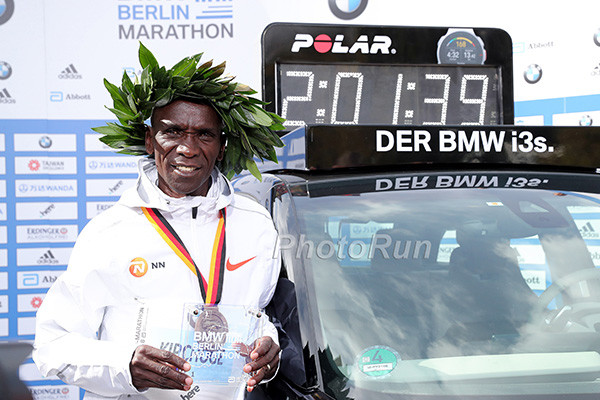
"I lack the words to describe how I feel," said Kipchoge. "It was really hard [during the last 17 kilometers] but I was truly prepared to run my own race.
I had to focus on the work I had put in in Kenya and that is what helped push me. I’m really grateful to my coaching team, my management, the organisation."
For the women, Gladys Cherono set a course record clocking 2:18:11. Second woman was Ruti Aga 2:18:34 and Trunesh Dibaba 2:18:55.
Login to leave a comment
Many of the top runners in the world come from Kenya and here is a good answer why
Kenya is known around the world as the home of champions and we wanted to know why. One tribe in Kenya that stands out more than others is the Kalenjins.
At the 1968 Olympics Kalenjin runner Kipchoge Keino defeated world-record holder Jim Ryun.
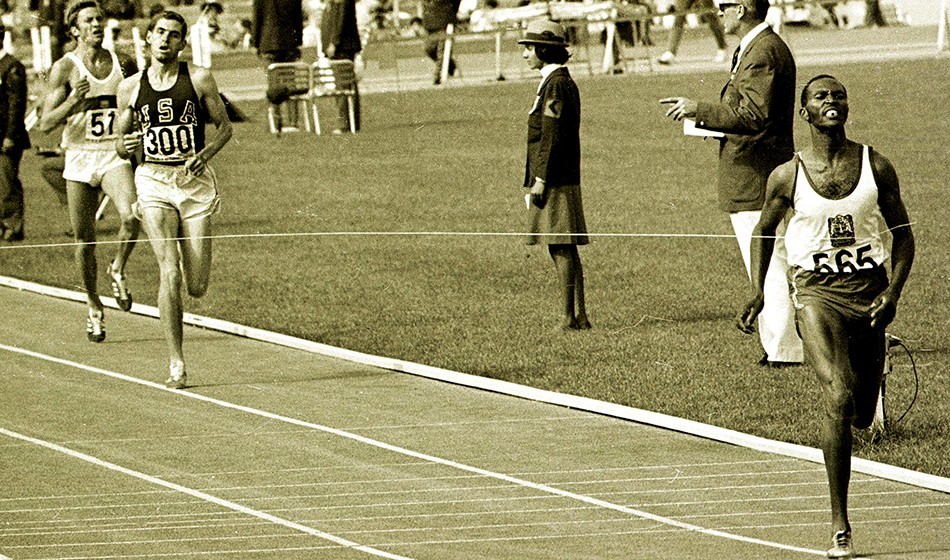
That day Keino not only won gold, but he also ushered in an era of Kenyan dominance. Since then a considerable number of the races are won by Kenyans and many world records are held by Kenyans. Many of these runners are of the Kalenjin tribe.
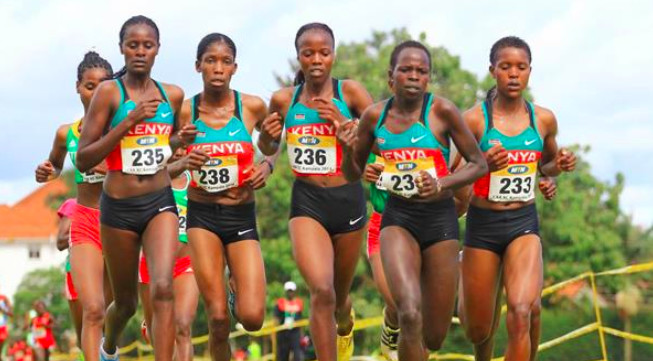
The feats have just bafflled the world. David Epstein a renown sports editor who authored a book called “The Sports Gene'” noted that many world-class runners in Kenya come from the tribe of Kalenjins. In his book, he explores possible genetic factors that might be the reason behind this.
He notes that Kalenjins have thin ankles and calves which makes their legs resemble a pendulum and eases their movement. According to his explanation, the more weight you have farther away from your center of gravity, the more difficult it is to swing.
The vice versa applies to Kalenjins. Some studies have also discovered that Kenyans, in general, have less mass for their height, longer legs, shorter torsos and more slender limbs. These physical traits can be viewed as relatively “streamlined” and improve efficiency while running.
Lastly, there is a controversial cultural argument that Kalenjins become great runners because they ran several miles to and from school barefoot on a daily basis.
Login to leave a comment


